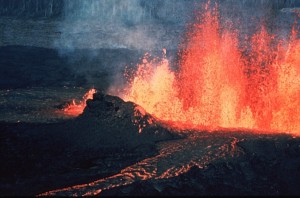
To the untrained eye, a rock is a rock, though some are prettier than others. Igneous rocks are more than pretty, though they are prized for their appearance and made into decorative, hard-wearing items. Igneous rocks are separated from other types of rocks through several characteristics of texture and composition.
Igneous rocks are formed from extreme heat, temperatures high enough to melt living things, so igneous rocks are unlikely to contain fossils. Acid has little effect on igneous rocks, which may be coarse or fine-grained. Made up of two or more kinds of minerals, these minerals are mixed together in liquid form so the rocks have little to no layering. The mineral crystals grow to different sizes, so they may look like glass fibers strung throughout the rock.
Fact 1: Igneous rocks are named after the Greek word for fire, as this melted rock comes out of hot places. Deep in the Earth’s core or near active volcanoes, Igneous magma comes to the surface and cools into solid rocks, as if they were formed by fire.
Fact 2: Cooling Igneous rocks crystalize but cool so quickly that the crystals don’t have long to form, making them short and thick. Large amounts of debris, water vapor, and gases are often trapped during this quick cooling process. The crystals that are visible in igneous rocks are trapped grains of mineral, not a result of the crystallization process.
Fact 3: Igneous rocks are divided into Extrusive and Intrusive types. Extrusive Igneous rocks come from magma reaching the Earth’s surface. Intrusive or plutonic Igneous rocks form from magma that is trapped in pockets deep in the Earth. It cools very slowly, over thousands or millions of years, giving the mineral grains and crystals a long time to form. This makes the texture of the final rock rather rough.
Fact 4: Obsidian is what most people think of as volcano rocks. These extrusive igneous rocks cool so fast that the result has the look of glass, black being the most common color.
Fact 5: The first rocks to form on the cooling planet Earth were igneous rocks.
Fact 6: Igneous rocks are also called plutonic rocks, after the Greek god of the underworld, Pluto. This is because the rocks seemed to pour out from under the ground, the domain of Pluto.
Fact 7: Mid-Ocean Ridges are chains of volcanoes under the ocean. Many of these are still active volcanoes, and magma flows out of them almost constantly. This has covered most of the ocean floor in a type of igneous rock called basalt.
Fact 8: Igneous rock is found in many products, including road paving asphalt, concrete, toothpaste, cosmetics. Granite is a type of igneous rock that is highly prized for its appearance and is used to make statues, countertops, and gravestones. Another igneous rock is gabbro, which is refined for the gold, chromium, and silver contained in it.
Fact 9: Pumice is found in many bathrooms as a beauty aid, but it is actually the lightest rock on Earth, and a type of igneous rock. It is formed when magma cools so quickly on the surface that it leaves air holes, and some pumice is light enough to float on water.
Fact 10: Most of the Earth’s crust, about 95%, and most mountains are made out of igneous rocks. Even the Moon is made of igneous rocks.










Leave a Reply